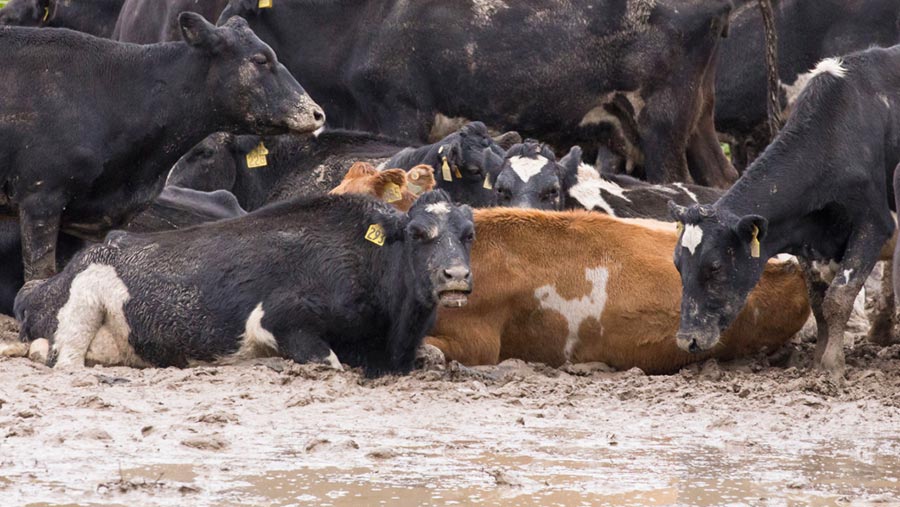Photos of mud-bound cows prompts NZ winter grazing task force
 © Angus Robson
© Angus Robson Photos of mud-bound cows in New Zealand have put winter grazing under the spotlight, with the country’s Minister of Agriculture ordering the establishment of a winter grazing task force.
Ag minister Damien O’Connor ordered the task force after environmentalist Angus Robson released photos of cows knee deep in mud in Southland and Otago.
The task force, which plans to meet in the next couple of weeks, will bring together vets, industry leaders and officials to look at the animal welfare issues associated with winter grazing and identify solutions.
Winter crop grazing is used in some parts of New Zealand to provide enough feed for stock at a time when there’s not enough pasture. Done well, it provides animals with quality feed to keep them warm over winter.

© Angus Robson
Speaking to Newshub, the minister said: “Images of cows up to their knees in mud, unable to lie down and rest and calving in these conditions is unacceptable to me and I’ve heard loud and clear from the public that it’s unacceptable to them too.”
Mr O’Connor said winter grazing also had an environmental impact which the Government was working on ways to address.
“The Government has bottom lines on animal welfare and there are some people falling well below acceptable practice. Unfortunately, it’s another situation of a small number of farmers letting the side down and bringing everyone into disrepute.”

© Angus Robson
UK situation
Outwintering cattle is also used in suckler and dairy production in the UK to minimise housing and bedding costs and the recent development in New Zealand acts as reminder to UK farmers ahead of the winter.
Managing the perception of outwintering is something farmers should be mindful of given the rise in animal welfare lobbyists and vegan groups, warned NFU’s chief livestock advisor John Royle.
See also: Outwintering dairy heifers on kale helps cut costs
“Consumers like the idea of extensively grazed animals and the beef and sheep sectors have a good story to tell. However, it only takes one badly posed photo for a different picture to be painted. All farmers have a responsibility to keep this in mind,” he said.
Mr Royle said farmers outwintering were responsible for selecting the right land and soil type for grazing, offering supplementary feed and having contingency shelter should the weather turn bad.
“In New Zealand they don’t have the same level of farm infrastructure that we have in the UK. We have buildings where animals can be housed.
“They also don’t have the same welfare rules or independent assurance schemes. Red Tractor standards specify livestock kept outdoors must have access to shelter and well-drained lying areas and that there must be controls in place to minimise overgrazing and poaching,” he said.
Advantages of outwintering:
- Reduced costs of straw bedding, machinery and feed
- Reduced wintering costs for all or part of the winter
- Availability of cow housing for alternative uses such as finishing more cattle
- Improved health for example, reduced pneumonia risk
- Even, efficient and low-cost distribution of manure
- Cattle often appear content and healthy
- Reduced labour requirements
Disadvantages include:
- Possible difficulty accessing fields during adverse weather
- Poaching around restricted feed areas/ring feeders
- Excess loss of body condition if stocking density too high in late autumn/early winter
- Increased risk of liver fluke from extended grazing period.
Top outwintering tips
- Choose free-draining, sandy soils to start with to minimise run-off.
- Put straw out in the field to give the cows something dry to lie on. This will enable them to lie down and conserve heat.
- Select fields with shelter. Or create shelter using bales, for example. Shelter should be provided such that the cows are protected from a number of wind directions and it should extend to about 0.5 to 1m above cow height. The shelter area should be well drained and dry out quickly after rain
- Fence off damaged areas to avoid repeated compaction and back fence where possible
- Monitor growth rates regularly to ensure cattle are growing at desired targets
- If animals are losing condition sometimes you need to accept that animals need to brought inside
- If feeding root crops such as fodder beet, double fence to avoid them gorging and resulting in acidosis. Measure the dry matter content of crop to ensure you’re allocating enough feed to meet live weight gain targets and weigh animals every 2-4 weeks to make sure they’re putting on enough weight.
